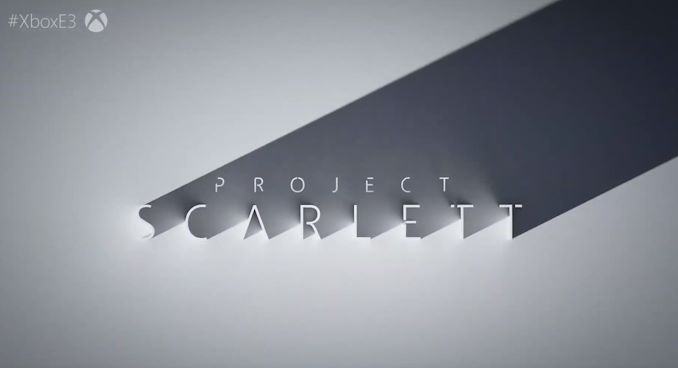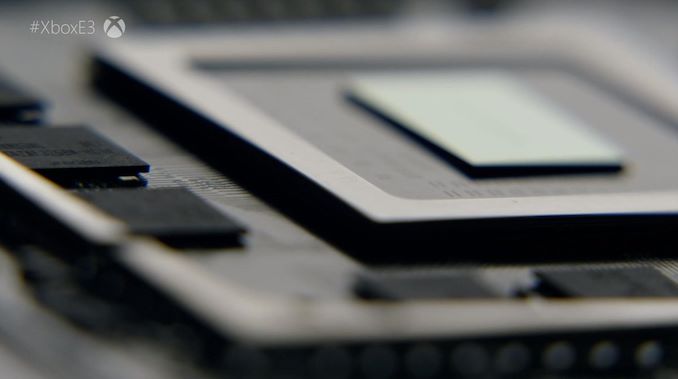Xbox at E3 2019: Xbox Project Scarlett Console Launching Holiday 2020
by Brett Howse on June 9, 2019 5:50 PM EST
Today at E3 Phil Spencer of Microsoft announced Project Scarlett, which is their next generation console and brings some massive performance increases over even the already powerful Xbox One X.
Once again partnering with AMD, Xbox Project Scarlett is, according to Microsoft, the biggest single generation leap in performance they’ve ever delivered, and it starts with its SoC. AMD is leveraging Zen 2 CPUs cores coupled with a Navi-based GPU. And while we don’t have the expected performance figures yet, these components are a big step up over the current generation.
Xbox One X is still based on Jaguar CPUs, which are a limiting factor, and adding Zen 2 is going to be an incredible step up in CPU performance, which has been the limiting factor of the Xbox One X. Coupling that with a Navi based GPU with hardware based Ray Tracing should provide a level of fidelity far above even the Xbox One X. Microsoft’s target for Project Scarlett was announced as 120 FPS (which we assume is at 4K) but also variable refresh rate, and support for up to 8K on the hardware. Microsoft states this console will be four times more powerful than the Xbox One X.
Microsoft is also going to be offering an internal SSD for the first time ever, and they discussed at length how they are going to leverage it to reduce the load times in games, which are a major block to immersion at the moment especially on consoles. Microsoft will be using some of the SSD as a RAM cache as well.
Microsoft also stated that they will continue to their tradition of moving gamers and the games they own onwards with this new launch, so existing Xbox One games and the back-catalog of backwards compatibility games will continue to be playable on the new console as well.
Project Scarlett will be launching in Holiday 2020 along with a new version of Halo to commemorate the launch. Not all details are available yet but we’ll keep you up to date when we hear more.












127 Comments
View All Comments
eastcoast_pete - Monday, June 10, 2019 - link
I am/was aware of the great similarities between PS4 and Xbox One. But, just because two consoles use the same basic tech doesn't mean they have to be almost identical. The PS4 Pro and the Xbox OneX share a lot of technical feature, but have different memory size and GPU compute power.mode_13h - Tuesday, June 11, 2019 - link
> Heck, the Xbox 360 CPU was pretty much 3 of the PPE from the PS3 Cell.No, not even close. The only similarity is that they're POWER-derived and in-order. That's about it. Everything else about how they're connected, how they're programmed, and how the access memory is different. MS even pointed out that they added a couple AltiVec instructions that Cell lacked - not sure if Cell has instructions not found in the 360.
Believe me, Cell programmers *wished* it was as easy to program as the 360, but if you could make your algorithm fit the way it worked, it had a beastly amount of compute power and bandwidth.
> AMD's really the only one that can offer an SoC with a relatively high-end CPU and GPU right now
True, but Intel will certainly be in contention, *if* there's another generation of consoles after this.
> nVidia would have to use a licensed ARM core for a CPU
Um, Xavier has 8 custom Nvidia-designed cores. This is their 3rd generation of custom ARM cores.
> why would anyone think AMD is going to develop two significantly different SoCs for products targeting the same market space at the same time?
Because Sony and MS are paying them. AMD is licensing their cores, but Sony and MS are in the driver's seat. How "custom" they are is basically just a matter of cost and time-to-market. Because of those pragmatic concerns, it's not surprising if neither customer makes very drastic customizations.
mode_13h - Tuesday, June 11, 2019 - link
Just want to clarify: AMD does contract design - Sony and MS *own* the resulting IP. So, it's not AMD deciding what to build for MS and Sony, but AMD is certainly providing access to their existing IP.mode_13h - Tuesday, June 11, 2019 - link
> the hardware differences between the Xbox One and PS4 were pretty minimal.Also, an overstatement, but not as bad as that PS3 vs. 360 nonsense.
The original XBox One had in-package video memory + DDR3, while the PS4 had unified GDDR5. That's a pretty big difference, right there. You certainly can't call it minimal. What's true is they both leveraged existing GCN cores, Jaguar CPU blocks, and probably some other AMD IP.
V900 - Monday, June 10, 2019 - link
So... The exact same Zen2/Navi combo that the PS5 will have.(Lemme guess, one of them will have a slightly higher clockspeed?)
No HW raytracing. Roughly RTX 2070 performance.
Boring!
TheUnhandledException - Monday, June 10, 2019 - link
What magical ponies were you expecting from a $300 to $500 PC which is what consoles are. I mean baring Microsoft or Sony finding some unobtanium they aren't going to cram 24 TFlops into something that has a pricetag of <$500 and pulls less than 200W.mode_13h - Tuesday, June 11, 2019 - link
The wildcard would be some custom hardware block that MS could stick in there. Like, they could build their own raytracing accelerator. Remember how they built a custom HPU, in the Hololens? They have their own hardware team, for that sort of thing.V900 - Monday, June 10, 2019 - link
Welp, guess all the guesses about the next Xbox using an Arcturus (Or other real RDNA) GPU were wrong.XBoxNext=PS5=Midrange 2018 PC. Only difference will be a few percent difference in clockspeed or something like that.
Eliadbu - Monday, June 10, 2019 - link
makes me wonder how did they calculate "4 times more powerful that the Xbox One x"since assuming that there are no major tweaks to the CPU and GPU architecture Navi top card would have around 9.75 Tflop and let say they scale it up teak somethings around and in real world use get it to be around twice as fast as Xbox one X GPU (which is already at 6Tflops) so where the other performance comes out? the CPU ? let say the CPU is twice faster so they can relate to the performance improvement as equal to CPU performance improvement * GPU performance improvement. does it make any sense ? IMO it does not and the should be clear how much faster the CPU ALONE and the GPU ALONE and not give some vague statement "4 times as powerful" or give real world benchmark comparison for general usecase that can show 4 times improvement .
eastcoast_pete - Monday, June 10, 2019 - link
The only way this is "4x more powerful" is on CPU compute power. Yes, 8 Zen-type cores should be about 4 times as powerful as the "custom Jaguar" cores. Now, if the GPU would be 4x the speed of the one in the Xbox One X, that'd be something to really write home about!